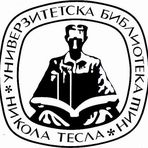Title
Karakteristike složenih kombinera u dva trenutka vremena u prisustvu fedinga
Creator
Nikolić, Petar B.
Copyright date
2015
Object Links
Select license
Autorstvo 3.0 Srbija (CC BY 3.0)
License description
Dozvoljavate umnožavanje, distribuciju i javno saopštavanje dela, i prerade, ako se navede ime autora na način odredjen od strane autora ili davaoca licence, čak i u komercijalne svrhe. Ovo je najslobodnija od svih licenci. Osnovni opis Licence: http://creativecommons.org/licenses/by/3.0/rs/deed.sr_LATN Sadržaj ugovora u celini: http://creativecommons.org/licenses/by/3.0/rs/legalcode.sr-Latn
Language
Serbian
Cobiss-ID
Theses Type
Doktorska disertacija
description
Datum odbrane: 14.09.2016.
Other responsibilities
mentor
Milić, Dejan
član komisije
Pronić-Rančić, Olivera 1969-
član komisije
Spalević, Petar
Academic Expertise
Tehničko-tehnološke nauke
University
Univerzitet u Nišu
Faculty
Elektronski fakultet
Group
Katedra za telekomunikacije
Alternative title
Characteristics of complex combiners at two time instants in the presence of fading
Publisher
[P. B. Nikolić]
Format
[19], 134 listova
description
Biobibliografija kandidata: list.123-134
description
Telecommunications
Abstract (en)
Performances of wireless telecommunications systems in the presence of noise,
interference and fading when the sampling is done at two time instants are discussed in this
dissertation. The goal of using this method is to improve reliability and increase capacity
without increasing the transmission power and transmission bandwidth, compared to
conventional combiner when sampling is done at one time instant.
During the transmission of digitally modulated signals through communication channels
some fluctuations in the amplitude of the received signal during short time intervals may
occur. This phenomenon is called fading. Total fading in the system is defined as a complex
combination of fading due to interference between two or more components of the signal
arriving from different paths and shadowing. Efficient and at the same time cost-effective
technique for reduce of fading and performance improvement are the diversity combining
technique. This technique is based on the random nature of the signal propagation, since the
useful signal is obtained using signals obtained from different branches of the receiver. If the
signal on one path is attenuated, at some specific moment the same signal that goes through a
different path can be stronger. In this way the existence of a more than one path can
significantly improve system performances. In this study, the combination of the spatial
diversity and sampling signals at two time points will be presented.
Selection combining (SC) and switch and stay combining (SSC) represent simple and
widely used techniques process only one branch of the receiver, opposed to maximum ratio
combining (MRC) and equal gain combining (EGC) that use all the received signals. When
using the SC combining technique, the signal at the output is equal to the highest value of the
combiner’s input signal. In the case of the SSC combiner with two branches, one branch is
selected, and it remains selected until the value of the signal or the signal to noise ratio stays
greater than a predefined threshold. When the signal value of the first branch is less than the
threshold, the combiner switches to another branch.
In this dissertation the SSC combiner with two inputs at two time instants is discussed.
The probability of events that combiner first analyse the signal from one of the inputs is the
same as for SSC combiner which considers one time instant, and it depends on the
probability distribution functions for the given threshold value at the input channels of the
SSC combiner. It is assumed that the signals are not correlated between the branches of the
receiver, which is the common case in mobile communications, and that there is a correlation
between the signals in one branch at the two different time instants. According to the SSC
combiner decision-making at two time instants, the expressions for the joint probability
density functions of the signals at the output of the SSC combiner at two time instants for
Rayleigh's, Nakagami-m, Rice's, Weibull, log-normal and gamma fading are obtained. In this
way, one can obtain parameters that characterize the performance of a complex SSC/SC
combiner.
Probability density functions for the signal derivatives at the SSC combiner output at two
time instances will be defined for several different fading types. For Rayleigh's, Nakagami-m,
Rice's and log-normal fading, signal derivatives have normal distribution with zero mean, and
they are mutually uncorrelated at two time instants, as well as with the signal itself. For
Weibull and gamma distribution signal derivatives also have a normal distribution, while the
variance of the derivative depends on the value of the signal, as shown in the literature. In
this case it could be assumed that the signal derivatives are mutually uncorrelated.
Performances of complex SSC/SC receiver at two time instants can be obtained when the
signals at the output of the SSC combiner are used as the inputs of the SC combiner. For
Rayleigh's, Nakagami-m, Rice's, Weibull, log-normal and gamma fading, one can obtain
expressions for probability density function and outage probability at the output of the
complex SSC/SC combiner. Outage probability and the average bit or symbol error rate are
the most commonly used parameters for performance measures of the SSC and SC diversity
system. However, in certain telecommunication wireless systems, these parameters do not
provide sufficient information for the design and configuration of the system, and the second
order statistics parameters are used instead, such as level crossing rate and average fade
duration. This is particularly important for the calculation of the transfer speed per symbol,
the length of the packet and the duration of the time slots. In this dissertation, it will be
presented the second order statistics of SSC/SC receiver. Using the expressions for joint
probability density function for the signal and the signal derivative at the output of the SSC
combiner at two time instants, the expression for level crossing rate will be obtained. The
average fade duration can be obtained using the level crossing rate and the outage probability.
The subject of this dissertation is a very topical from a scientific point of view, because
with the development of mobile and wireless telecommunications, the use of these systems in
the transmission of telecommunications signals significantly increases. Results presented in
this thesis can have many practical applications.
Authors Key words
Feding, kombinovanje, gustina raspodele verovatnoce, karakteristike drugog reda,
verovatnoca otkaza, SSC kombiner, SC kombiner
Authors Key words
Fading, combining, probability density function, second order characteristics, outage
probability, SSC combiner, SC combiner
Classification
621.391:621.3.037.372.524
Type
Elektronska teza
Abstract (en)
Performances of wireless telecommunications systems in the presence of noise,
interference and fading when the sampling is done at two time instants are discussed in this
dissertation. The goal of using this method is to improve reliability and increase capacity
without increasing the transmission power and transmission bandwidth, compared to
conventional combiner when sampling is done at one time instant.
During the transmission of digitally modulated signals through communication channels
some fluctuations in the amplitude of the received signal during short time intervals may
occur. This phenomenon is called fading. Total fading in the system is defined as a complex
combination of fading due to interference between two or more components of the signal
arriving from different paths and shadowing. Efficient and at the same time cost-effective
technique for reduce of fading and performance improvement are the diversity combining
technique. This technique is based on the random nature of the signal propagation, since the
useful signal is obtained using signals obtained from different branches of the receiver. If the
signal on one path is attenuated, at some specific moment the same signal that goes through a
different path can be stronger. In this way the existence of a more than one path can
significantly improve system performances. In this study, the combination of the spatial
diversity and sampling signals at two time points will be presented.
Selection combining (SC) and switch and stay combining (SSC) represent simple and
widely used techniques process only one branch of the receiver, opposed to maximum ratio
combining (MRC) and equal gain combining (EGC) that use all the received signals. When
using the SC combining technique, the signal at the output is equal to the highest value of the
combiner’s input signal. In the case of the SSC combiner with two branches, one branch is
selected, and it remains selected until the value of the signal or the signal to noise ratio stays
greater than a predefined threshold. When the signal value of the first branch is less than the
threshold, the combiner switches to another branch.
In this dissertation the SSC combiner with two inputs at two time instants is discussed.
The probability of events that combiner first analyse the signal from one of the inputs is the
same as for SSC combiner which considers one time instant, and it depends on the
probability distribution functions for the given threshold value at the input channels of the
SSC combiner. It is assumed that the signals are not correlated between the branches of the
receiver, which is the common case in mobile communications, and that there is a correlation
between the signals in one branch at the two different time instants. According to the SSC
combiner decision-making at two time instants, the expressions for the joint probability
density functions of the signals at the output of the SSC combiner at two time instants for
Rayleigh's, Nakagami-m, Rice's, Weibull, log-normal and gamma fading are obtained. In this
way, one can obtain parameters that characterize the performance of a complex SSC/SC
combiner.
Probability density functions for the signal derivatives at the SSC combiner output at two
time instances will be defined for several different fading types. For Rayleigh's, Nakagami-m,
Rice's and log-normal fading, signal derivatives have normal distribution with zero mean, and
they are mutually uncorrelated at two time instants, as well as with the signal itself. For
Weibull and gamma distribution signal derivatives also have a normal distribution, while the
variance of the derivative depends on the value of the signal, as shown in the literature. In
this case it could be assumed that the signal derivatives are mutually uncorrelated.
Performances of complex SSC/SC receiver at two time instants can be obtained when the
signals at the output of the SSC combiner are used as the inputs of the SC combiner. For
Rayleigh's, Nakagami-m, Rice's, Weibull, log-normal and gamma fading, one can obtain
expressions for probability density function and outage probability at the output of the
complex SSC/SC combiner. Outage probability and the average bit or symbol error rate are
the most commonly used parameters for performance measures of the SSC and SC diversity
system. However, in certain telecommunication wireless systems, these parameters do not
provide sufficient information for the design and configuration of the system, and the second
order statistics parameters are used instead, such as level crossing rate and average fade
duration. This is particularly important for the calculation of the transfer speed per symbol,
the length of the packet and the duration of the time slots. In this dissertation, it will be
presented the second order statistics of SSC/SC receiver. Using the expressions for joint
probability density function for the signal and the signal derivative at the output of the SSC
combiner at two time instants, the expression for level crossing rate will be obtained. The
average fade duration can be obtained using the level crossing rate and the outage probability.
The subject of this dissertation is a very topical from a scientific point of view, because
with the development of mobile and wireless telecommunications, the use of these systems in
the transmission of telecommunications signals significantly increases. Results presented in
this thesis can have many practical applications.
“Data exchange” service offers individual users metadata transfer in several different formats. Citation formats are offered for transfers in texts as for the transfer into internet pages. Citation formats include permanent links that guarantee access to cited sources. For use are commonly structured metadata schemes : Dublin Core xml and ETUB-MS xml, local adaptation of international ETD-MS scheme intended for use in academic documents.


